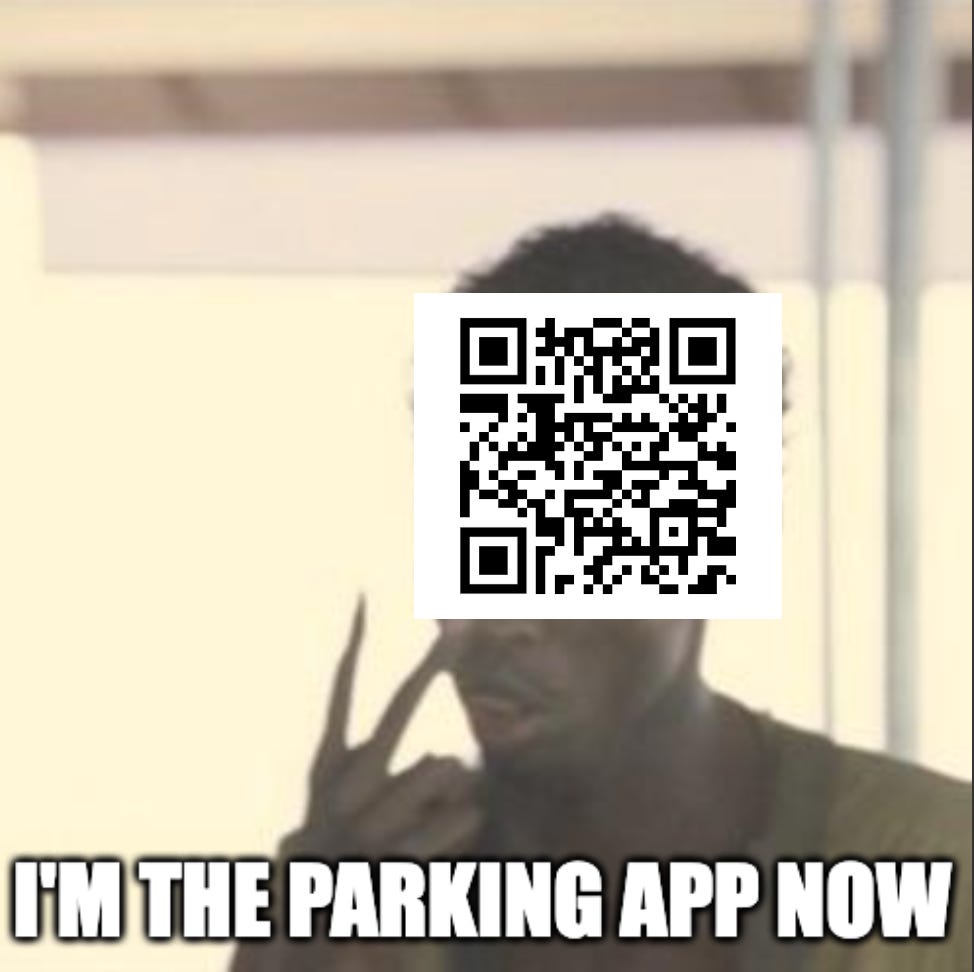From the Fire: Q3FY25
Living off the land, hiding in plain sight, and outsmarting controls.
While ransomware gangs made headlines this summer (hugops to the Minnesota National Guard), the real damage came from attacks that looked like business as usual. A tired employee approving their 47th push notification. An executive on a video call authorizing a routine transfer. A lunch order scanned from a QR code in the lobby. By the time anyone realized something was wrong, the attackers had already moved on to their next target.
The most effective attacks in Q3 were psychologically clever. Attackers learned to exploit the gap between security theater and actual security. They turned MFA prompts into a numbers game, betting someone would eventually click approve. Deepfakes were used sparingly but effectively, targeting specific executives for specific transactions. Legitimate QR codes were replaced with malicious ones, knowing most people scan first and think later (RIP my years of no parking tickets). These anomalies are hard to spot in traditional security tools due to the noise of everything else happening in an organization.
The patterns documented here emerged from incident response engagements across industries this quarter. Some you may recognize from your own environment. Others may be operating right now, undetected, waiting for the right combination of fatigue and trust. If Q3 showed us anything, it’s that next quarter’s attacks will look even more like normal business operations.
Deepfake Social Engineering at Executive Scale 🎭
The summer started with some extra heat when the U.S. State Department warned diplomats that an impostor using AI had attempted to reach out to at least three foreign ministers, a U.S. senator, and a governor. The impostor posed as Secretary of State Marco Rubio through text, Signal, and voicemail. In parallel, we saw Kimsuky launch a sophisticated spear phishing campaign against South Korean defense institutions, using AI-generated deepfake military ID cards that fooled even trained security personnel.
OpenAI CEO Sam Altman warned at a Federal Reserve event about an impending “fraud crisis” triggered by AI’s ability to impersonate anyone. Altman even admitted, “AI has fully defeated most of the ways that people authenticate currently, other than, like, passwords…” Recent research reveals that losses attributed to attacks involving deepfakes have risen to $1b in 2025, 2x the amount from 2024.
Tactics: Initial Access, Defense Evasion, Collection, Impact
T1656 – Impersonation
AI-generated deepfakes of executives in real time video/voice calls
T1591.004 – Gather Victim Org Information: Identify Roles
Researching executive hierarchies and approval chains for targeted impersonation
T1593.001 – Search Open Websites/Domains: Social Media
Harvesting voice samples from earnings calls, LinkedIn videos, and conference recordings
T1566.002 – Phishing: Spearphishing Link
Messages with links to video calls featuring deepfaked executives
T1204.001 – User Execution: Malicious Link
Victims clicking on video/voice call links that host deepfaked participants
T1534 – Internal Spearphishing
Using deepfaked executive voices/videos to request actions from employees
What You Should Be Looking For:
Video call anomalies: Executives joining from personal devices, unusual backgrounds, slight audio delays, requests to keep cameras off during “critical decisions”
Pattern breaks: CEO requesting wire transfers without board approval, CFO bypassing normal payment workflows, urgent requests during off-hours or vacations
Multi-channel inconsistencies: Video call followed immediately by Slack/Teams confirmation from a different device, email headers showing different geographic origins, use of non-standard communication channels (WhatsApp)
Technical artifacts: Compression artifacts around faces, unnatural eye movements, voice pitch variations, background noise inconsistencies
Data Sources:
Video conferencing audit logs (Teams, Zoom, WebEx)
Wire transfer approval systems
Executive calendar systems for meeting verification
Email security gateways analyzing sender behavior
Financial approval workflow exceptions
Voice biometric analysis systems (if deployed)
Messaging app logs (Signal, WhatsApp, SMS)
Resources:
AI impostor attempts to impersonate Secretary of State Rubio to foreign ministers and U.S. officials
Kimsuky APT uses AI-generated military IDs in defense sector attacks
National Cybersecurity Awareness Month: How to Protect Yourself from Deepfakes
Death by a Thousand Push Notifications 📱
In September 2025, BBC cyber correspondent Joe Tidy became the target of a sophisticated insider recruitment attempt by the Medusa ransomware gang that escalated into an MFA bombing campaign when he refused their offer of 25% of a multi-million dollar ransom. When recruitment failed, the attackers pivoted to flooding his phone with authentication requests, hoping he’d accidentally approve just one.
New reports also reveal that 79% of business email compromise victims investigated in 2024-2025 had MFA enabled, with approximately 25% of recent attacks involving fraudulent MFA push notifications. The technique has become so prevalent that ransomware crews like Scattered Spider and Muddled Libra have adopted MFA bombing as a standard part of their playbook.
CyberProof SOC analysts identified compromised accounts where attackers successfully bypassed MFA using mobile app notifications. Audit logs showed all authentication attempts as “successful,” despite originating from Cloudflare IP addresses. The attacks left no traditional indicators of compromise, as all sign-ins appear legitimate.
Tactics: Initial Access, Persistence, Defense Evasion
Techniques:
T1621 – Multi-Factor Authentication Request Generation
Triggering repeated MFA prompts to exhaust users
T1078 – Valid Accounts
Using compromised credentials to trigger legitimate MFA prompts
T1111 – Two-Factor Authentication Interception
Capturing approval when user finally accepts
T1556.006 – Modify Authentication Process: Multi-Factor Authentication
Following up with device enrollment once inside
What You Should Be Looking For:
Push patterns: Multiple MFA requests within minutes, especially outside business hours (midnight to 6 AM anyone?), requests during user PTO/weekends, geographic impossibilities between pushes
Approval anomalies: Acceptance after 10+ denials, approvals at unusual hours, immediate new device enrollment post-approval, first time user approving without verification
Behavioral breaks: MFA from new locations immediately after password reset, push notifications while user actively working elsewhere, requests from IPs in sanctioned countries
Support correlations: Help desk tickets about “broken MFA” followed by successful authentication, users reporting “ghost” notifications, complaints about overnight push spam
Data Sources:
MFA provider logs (Duo, Okta Verify, Microsoft Authenticator)
Authentication event correlation
Time-based analysis of push patterns
User complaint/ticket systems
VPN logs showing active sessions during push attempts
Mobile device management (MDM) enrollment logs
Employee reports of suspicious contact attempts
Resources:
79% of BEC victims had MFA enabled, 25% of attacks involve fraudulent push notifications
CyberProof SOC analysis of MFA bypass using Cloudflare IPs to mask attacker location
Defending Against UNC3944: Cybercrime Hardening Guidance from the Frontlines
The Low Tech High Tech Attacks 🏷️
In July 2025, Cyble Research & Intelligence Labs uncovered “Scanception,” a sophisticated credential-harvesting campaign active across more than 50 nations that exploited PDF attachments with embedded QR codes, with nearly 80% of the 600+ unique phishing PDFs showing zero detections on VirusTotal. The attacks targeted personal mobile devices in order to shift the attack surface away from enterprise visibility and defeat email gateways that only scan for clickable links.
But the digital attacks were just half the story. The summer of 2025 saw a coordinated wave of physical QR code attacks across North America. In June, New York City discovered fraudulent QR code stickers on ParkNYC meters that directed users to third-party websites requesting credit card information. By July, Denver reported fake QR codes on parking signs in Cherry Creek, Broadway, and Lincoln Street that sent users to international websites instead of the city’s Pay By Phone app. And in Montreal, the Agence de mobilité durable warned that vandals had placed malicious QR codes on signs meant to promote their new Mobicité parking app. Meanwhile, nation-state actors used QR codes to compromise messaging accounts of military personnel through Signal, distributing remote access trojans (RATs) that provided full device access.
Tactics: Initial Access, Defense Evasion, Credential Access
Techniques:
T1566.001 – Phishing: Spearphishing Attachment
PDFs masquerading as HR handbooks with QR codes on final pages to evade detection
T1204.001 – User Execution: Malicious Link
QR codes redirecting through YouTube, Google, Bing, Cisco, and Medium to mask malicious intent
T1598.003 – Phishing for Information: Spearphishing Link
AITM phishing pages that detect automation tools and redirect to “about:blank” when analysis detected
T1027.009 – Obfuscated Files or Information: Embedded Payloads
Split QR codes divided into two benign-looking images, nested codes with legitimate codes embedded inside malicious ones
T1608.005 – Stage Capabilities: Link Target
Physical QR code stickers overlaid on legitimate parking meters and signage
What You Should Be Looking For:
Email indicators: PDFs with 4+ pages placing QR codes on final pages, professional-looking documents with tables of contents mimicking HR workflows
Physical red flags: Stickers on parking meters with URLs one letter off from legitimate services (poybyphone vs PayByPhone), fresh adhesive or misaligned stickers over existing codes
Redirection patterns: Links routing through trusted platforms with base64-encoded victim email addresses appended as parameters
Detection evasion: Pages that disable right-click, monitor for debugging every 100ms, detect Selenium/PhantomJS/Burp Suite and immediately redirect
Mobile behaviors: Users scanning work-related QR codes with personal devices, authentication requests immediately after QR scan
Data Sources:
Email gateway logs for PDF/image attachments
Mobile device management (MDM) for personal device usage
Web proxy logs showing redirects through trusted platforms
URL inspection services for QR payload analysis
Physical security reports of tampered signage
Browser fingerprinting attempts in access logs
Resources:
Cyble uncovers “Scanception” campaign using PDFs with embedded QR codes across 50+ nations
NYC discovers fraudulent QR codes on ParkNYC meters directing to third-party sites
Denver reports fake QR codes on parking signs across multiple neighborhoods
Montreal warns of vandalized parking signs with malicious QR codes
Barracuda discovers split and nested QR code techniques evading detection
Nation-state actors use QR codes to compromise military Signal accounts
Conclusion
These are the behaviors that defined Q3. They weren’t sophisticated, they were mostly… human. Attackers weaponized fatigue with MFA bombing, trust with deepfaked executives, and convenience with QR codes stuck over parking meters. Each technique turned a security control into an attack vector.
What patterns are you seeing that don’t match these signatures? Which trust mechanisms are being weaponized in your environment? Drop a comment with the living-off-the-land techniques keeping you up at night, and we might feature your insights in the next From the Fire.





Thanks for writing this, it clarifys a lot. I completely agree with your assessment. The psychological aspect of these attacks is exactly what makes them so effective and hard to spot. It's smart how they exploit human nature. This is super insightfull.